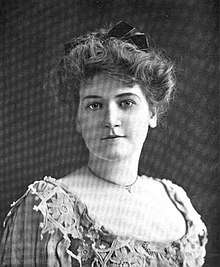Lotta Linthicum
Lotta Linthicum (born in the 1870s, died 1952) was an American actress on Broadway.
Lotta Linthicum | |
|---|---|
 Lotta Linthicum, from a 1904 publication. | |
| Born | Charlotte Linthicum 1870s New York City |
| Died | 1952 Port Chester, New York |
| Nationality | American |
| Other names | Lottie Linthicum, Lotte Linthicum, Lotta Lynn |
| Occupation | actress |
Early life
Lotta Linthicum was born in New York City, the daughter of William Oliver Linthicum and Julia Clark Bogardus Linthicum. After her father's death, she and her mother also lived in France and England, where Lotte trained in music, drama, and art.[1][2] She was photographed by Alfred Stieglitz on one ocean crossing, in 1894.[3] She and her mother had a home in Sconset, The Moorings, which was described as "a kind of social headquarters" for the summer colony of actors there, "full of unique souvenirs".[4]
Career
Lotta Linthicum had a long career on the stage,[5] from the 1890s to the 1930s, mainiy in London,[6] Montreal,[7] and New York. Broadway appearances by Lotta Linthicum included roles in Love Finds the Way (1898), The Royal Box (1898), Lady Rose's Daughter (1903), The Deserters (1910),[8] Frou-Frou (1912), Cheer Up (1912-1913),[8] A Tailor-Made Man (1917-1918, 1929),[9] The Little Whopper (1919-1920), Blue Eyes (1921), Icebound (1923),[10] The Shelf (1926), Piggy (1927),[11] The Wild Man of Borneo (1927),[11] Atlas and Eva (1928),[12] Skyrocket (1929),[11] Nice Women (1929),[11] She Lived Next to the Firehouse (1931), and Papavert (1931-1932). She was also seen in other shows, including The Sign of the Cross (1896),[13] Weather-Beaten Benson (1904), Skipper & Co. (1911)[14] Madame Sherry (1913),[15] The Crinoline Girl (1914),[16] Don't Do It Dodo (1936),[17] and the suffrage production A Pageant of Protests.[18]
Linthicum traveled with pet dogs, especially of the pug and Pomeranian breeds.[19] She also bred Pomeranians,[20] and showed her dogs in competitions.[21]
Personal life
Lotta Linthicum married three times. Her first husband was fellow actor James William Bankson; they married in 1899,[22] and he died with typhoid in 1900, at age 22.[23] Bankson was violent towards Linthicum, enough to cause public comment and police involvement.[24] Her second husband was William Cantwell Strachan, a Canadian theatre professional; they married in 1905, and divorced in 1913.[25] Her third husband was Armor W. Barbour (they married about 1915). Her later years saw her in financial straits; her art and other belongings were auctioned over time.[26] She died in Port Chester, New York, in 1952, when she was about eighty years old.
References
- Sheridan, Mattie (March 13, 1891). "A Few Words about Society". The Epoch. 9: 93.
- "Who's Who on the Stage". The New York Times. April 5, 1925. p. X4 – via ProQuest.
- Francisco, Jason; McCauley, Elizabeth Anne (2012-02-12). The Steerage and Alfred Stieglitz. University of California Press. pp. 26–27. ISBN 9780520266223.
- "An Actors' Summer Colony". The Theatre Magazine. 2: 6–8. August 1902.
- "Miss Lotta Linthicum, an Actress of Prominence and Artistic Ability" Broadway Weekly (March 10, 1904): 10.
- "Among the Players". The Peterson Magazine. 7: 183. February 1897.
- "Lotta Linthicum's Offer". The Indianapolis News. November 28, 1900. p. 3. Retrieved April 28, 2019 – via Newspapers.com.
- Hines, Dixie; Hanaford, Harry Prescott (1914). Who's who in Music and Drama. H.P. Hanaford. pp. 378, 463.
Lotta Linthicum.
- "Scenes in Harry James Smith's Comedy 'A Tailor-Made Man'". Theatre Magazine. 26: 210. October 1917.
- Roberts, Jerry (2003). The Great American Playwrights on the Screen: A Critical Guide to Film, Video, and DVD. Hal Leonard Corporation. p. 133. ISBN 9781557835123.
- Hischak, Thomas S. (2009-04-22). Broadway Plays and Musicals: Descriptions and Essential Facts of More Than 14,000 Shows through 2007. McFarland. pp. 325, 361, 425, 509. ISBN 9780786453092.
- Allen, Kelcey (February 7, 1928). "'Atlas and Eva' Presented at the Mansfield". Women's Wear Daily. p. 13 – via ProQuest.
- "Lotta Linthicum in the role of Dacia from a production of THE SIGN OF THE CROSS, ca. 1896". cdm16786.contentdm.oclc.org. Retrieved 2019-04-28.
- York, American Play Company, New (1911). The Catalogue of the American Play Co., with Original Casts. The Company. p. 243.
- Murdock, Julia (July 22, 1913). "Julia Murdock Praises Poli Players for Cleverness in Musical Comedy". The Washington Times. p. 8. Retrieved April 28, 2019 – via Newspapers.com.
- Times, Special to The New York (1904-09-02). "EZRA KENDALL'S NEW PLAY.; First Production of". The New York Times. p. 7. ISSN 0362-4331. Retrieved 2019-04-28.
- "Two New Comedies Here Next Week". The Baltimore Sun. November 6, 1936. p. 12. Retrieved April 28, 2019 – via Newspapers.com.
- "Characters in "A Pageant of Protests" given by leading suffrage workers of New York in the Broadway Theater". Library of Congress, Washington, D.C. 20540 USA. Retrieved 2019-04-28.
- "Kennel of Poms Keeps Actress Busy and Happy". Daily News. June 25, 1923. p. 40. Retrieved April 28, 2019 – via Newspapers.com.
- "A 'Pom' For You (advertisement)". Country Life. 42: 19. June 1922.
- "Big Little Dogs". Daily News. January 27, 1922. p. 28. Retrieved April 28, 2019 – via Newspapers.com.
- "Lotta Linthicum". Buffalo Courier. June 4, 1899. p. 6. Retrieved April 28, 2019 – via Newspapers.com.
- "Obituary Notes". The New York Times. August 17, 1900. p. 7 – via ProQuest.
- "Sorosis Discusses Lotta Linthicum". The Buffalo Review. September 29, 1899. p. 2. Retrieved April 28, 2019 – via Newspapers.com.
- "Actress Seeks Freedom". The Gazette. October 31, 1913. p. 2. Retrieved April 28, 2019 – via Newspapers.com.
- "Remington Bronzes Sold". The New York Times. November 20, 1938. p. 46 – via ProQuest.
External links
- Lotta Linthicum at the Internet Broadway Database
- Lotta Linthicum, Broadway Actress, a blog maintained in November 2007 by John Phillips
- A photograph of Lotta Linthicum from before 1910, in the collection of the Museum of the City of New York.